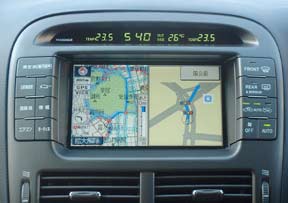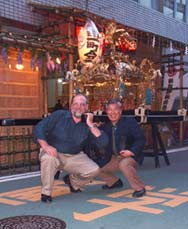
Shinto Shrine Festival in TokyoHiroshi Hashimoto drives his car as though he's been driving in the crush of Tokyo traffic all his adult life -- which, of course, he has. His sleek black Toyota, of a model that would be in the Lexus line in the U.S., is the most sophisticated automobile I've ever been in. 
In the middle of the dashboard, to the left of the right-side steering wheel, is a split screen GPS console that delivers an astonishing variety of information. Surprisingly, Mr. Hashimoto's skill at operating the fingertip controls while navigating the narrow side roads of Tokyo provided me with no concern whatsoever as I watched intently from the back seat. In addition to the normal items such as maps, trip routing and traffic density displays, the unit featured real-time voice prompts notifying when to change to alternate routes due to momentary congestion. The console even allowed him to send and receive e-mail! 
The festival was located in the same area of town as Kyoei's downtown office, so Hashimoto drove down the alley behind his building to park. When we arrived, I was introduced to one of Japan's high-density parking systems, the auto turntable. He pulled the car onto a flat metal disk about 10 feet in diameter. It was embedded in the driveway surface directly in front of a sliding door on the side of the building. As the rest of us made our exit from the car, Hiroshi went to a control panel to the right of the door and punched in his personal code. The sliding door opened to reveal a multi-story elevator system designed to stack cars inside automatically. He drove the car inside the building, onto the waiting lift. Once again pushing the buttons on the panel on the outside wall, the door closed and the car was automatically lifted inside the building, sort of like a ferris wheel. The disk, I learned, is to spin the car 180 degrees when we pick it up, so it can once again be headed in the correct direction. A slick system, and one in widespread use in space-starved downtown Tokyo. 
Hashimoto led us without hesitation in a particular direction. Before long, I heard the sound of chanting in the distance, and soon caught sight of a group of people dressed in matching costumes in the middle of a nearby street. Most of the group members were surrounding several others of their shrine who were holding an alter-like object above their heads. The chanting was gruff and rhythmic, yet lyrically captivating. Behind the group trailed some onlookers like us, as well as some smaller children dressed like the adults. Most of the kids were holding tightly onto the hands of what could only have been their mothers. 

This was an annual festival that had been held for many years, Hiroshi told us. The celebration used to be more widespread, since the area had long been one where many Shinto shrines were located. In recent times, however, the price of land was squeezing out that usage, in favor of businesses locating there. 
I was glad to have an opportunity to witness this glimpse into Tokyo's past, and grateful for our host's willingness to share with us this intimate look into the culture of his city. As we walked back toward the car, I spied another ingenious device I'd never seen before, this one for parking. It was a way to ensure that car owners using a parking lot paid the money owed, without the lot owner having to remain in attendance. As you can see from the photo, a metal flap is sticking up underneath the car. This barrier, which runs full width of the parking space, pops up automatically a few minutes after the car is parked. When the driver returns, s/he deposits the amount of money needed and the bar drops back down into the pavement, allowing the car to leave. 
When we arrived back at his building, Hiroshi pushed some buttons on the control panel and we could hear the elevator mechanism start up inside. In about a minute, the door opened to reveal his car positioned behind it. He backed the automobile out onto the turntable, got out and again punched buttons on the control panel, and the turntable swung his car around 180 degrees so the front pointed out the exit. No backing up needed! (Although I didn't get a picture of Hiroshi's black Toyota, I did manage to take these shots of another vehicle exiting the garage so I could illustrate the turntable in action.) 
Hiroshi then showed us another handy feature his state-of-the-art Toyota offered. He locked the doors, then invited me to try to open one. I couldn't; the handle was securely locked. Then, Hashimoto walked up to the car and magically opened the door as if the car weren't even locked! As it turned out, for him it wasn't. The secret was the high-tech keychain in his pocket, which identified him as the car's owner. When the keychain was in close proximity to the doors or the trunk, they were unlocked automatically. By now, it was time for us to head toward the restaurant where we'd promised to meet Hiroshi's son, Tetsuji, and our other traveling companion, Steve. Little did I know my new sweeping contractor friends were about to take me to the Japanese meal of a lifetime!
|

